Key takeaways:
- E-reading solutions enhance accessibility through customization options like font adjustments and text-to-speech features, making literature more inclusive for diverse needs.
- Challenges such as poor screen reader compatibility and inadequate color contrast can hinder accessibility, emphasizing the need for thoughtful design in e-books.
- Popular e-reading tools like Kindle and Adobe Digital Editions provide features that enhance user experience, including customizable layouts and annotation capabilities.
- Personal experiences highlight the transformative impact of e-books on reading habits, fostering community and enhancing convenience for users.
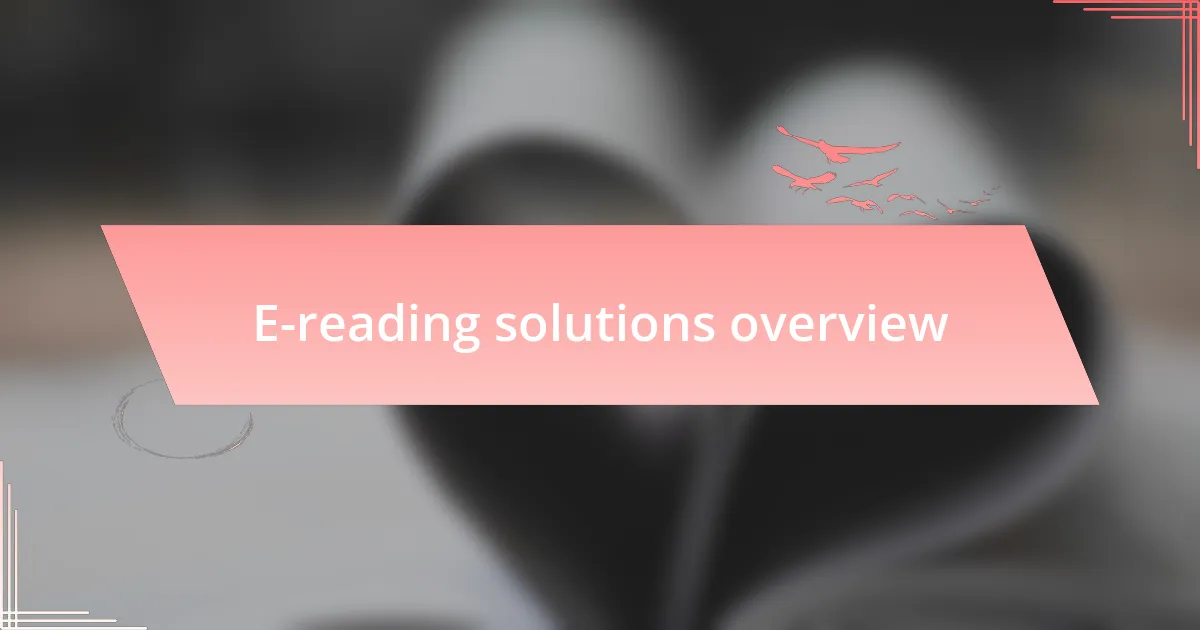
E-reading solutions overview
E-reading solutions have transformed the way we access literature, providing a seamless interface to dive into books anytime and anywhere. I remember the days of lugging around heavy novels during my daily commute; now, a compact device can hold an entire library. Isn’t it remarkable how technology has made reading more accessible and convenient?
One of the exciting aspects of e-reading is the customization it offers. For those who struggle with visual impairments, adjusting font sizes or colors can make a world of difference. I’ve spoken with friends who use these features and find it empowering, allowing them to enjoy stories without the discomfort they faced with traditional print.
Moreover, e-readers often come equipped with features like text-to-speech, further enhancing accessibility. I often wonder how many potential readers might have been lost without these advancements. Personally, I find it fulfilling to explore these technologies that cater to diverse needs, knowing that more people can now experience the joy of reading, no matter their circumstances.
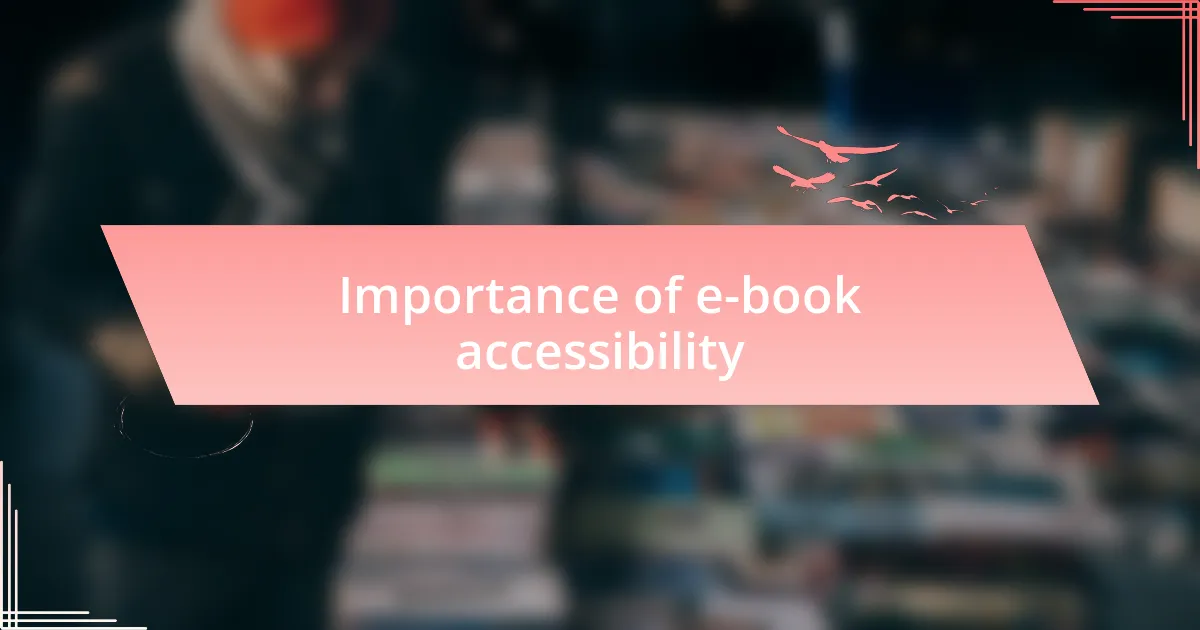
Importance of e-book accessibility
When discussing the importance of e-book accessibility, it’s crucial to consider the diverse needs of readers. I once met a woman at a local café who had given up reading due to her deteriorating eyesight. She shared how, after discovering accessible e-books, she not only returned to her beloved novels but found new genres to explore. Isn’t it amazing how technology can reignite a passion for reading?
Accessibility in e-books goes beyond just font sizes and colors; it opens doors for everyone. I remember a group of students with learning disabilities who struggled with traditional textbooks. Their enthusiasm for learning soared once they accessed interactive e-books tailored to their needs. This shift sparked conversations about inclusivity, highlighting that everyone deserves the right to read and learn at their own pace.
It’s also worth noting that e-book accessibility fosters a more inclusive community. One day, while volunteering at a literacy program, I witnessed a deaf participant fully engage with a story because of captions and sign language tabs in an e-book. This moment struck me profoundly. It reinforced my belief that making literature accessible means allowing every voice to be heard, ensuring no one is left behind in the world of storytelling.
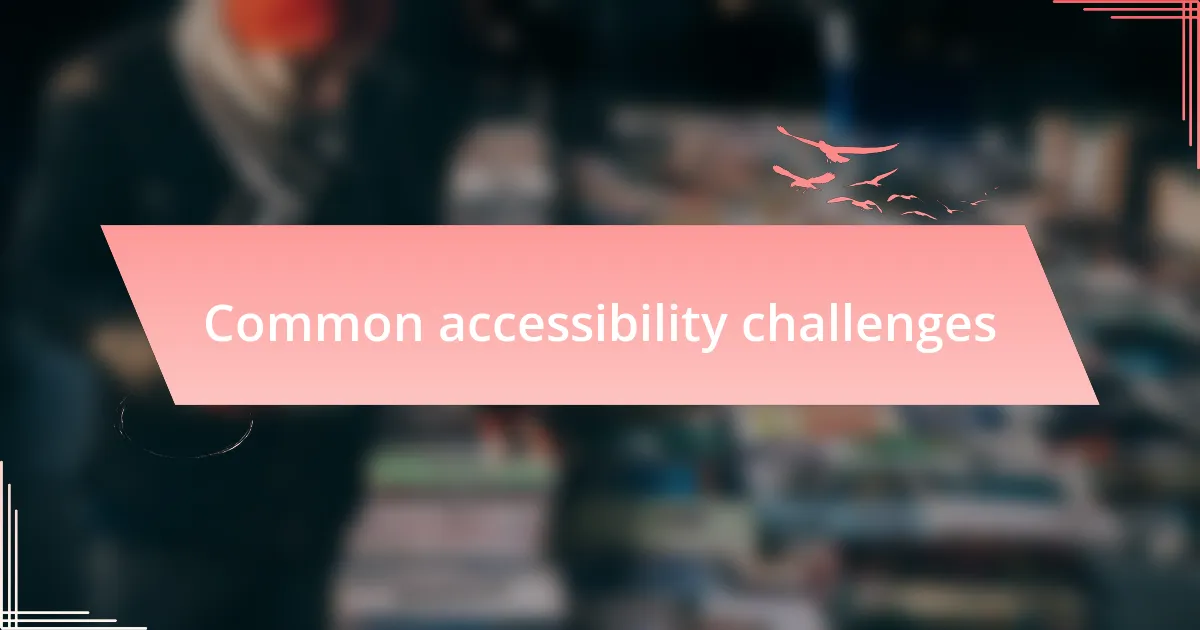
Common accessibility challenges
When I think about common accessibility challenges in e-books, the first thing that comes to mind is the often overlooked issue of screen readers. I once watched a friend, who relies on one due to visual impairment, struggle with an e-book that wasn’t properly formatted. The frustration on his face was palpable as he navigated through a sea of text that wasn’t read in the order it was meant to be. It’s striking how something so simple can be so impactful, isn’t it?
Another challenge arises with color contrast, which can make or break the reading experience. I remember a moment in a digital library where a friend with dyslexia tried to read an e-book with poor contrast. The text blended into the background, and her excitement swiftly turned to discouragement. It’s essential to consider that not everyone perceives colors the same way, and this simple oversight can lead to significant barriers.
Lastly, I can’t ignore the issue of complex navigation. I once tried to help a senior relative use an e-reader filled with intricate menus and buttons. The confusion on her face was heart-wrenching as she struggled to locate the settings she needed to adjust for her hearing difficulties. When technology isn’t intuitive, it creates unnecessary obstacles. Isn’t it crucial that e-books be designed with user-friendliness in mind?
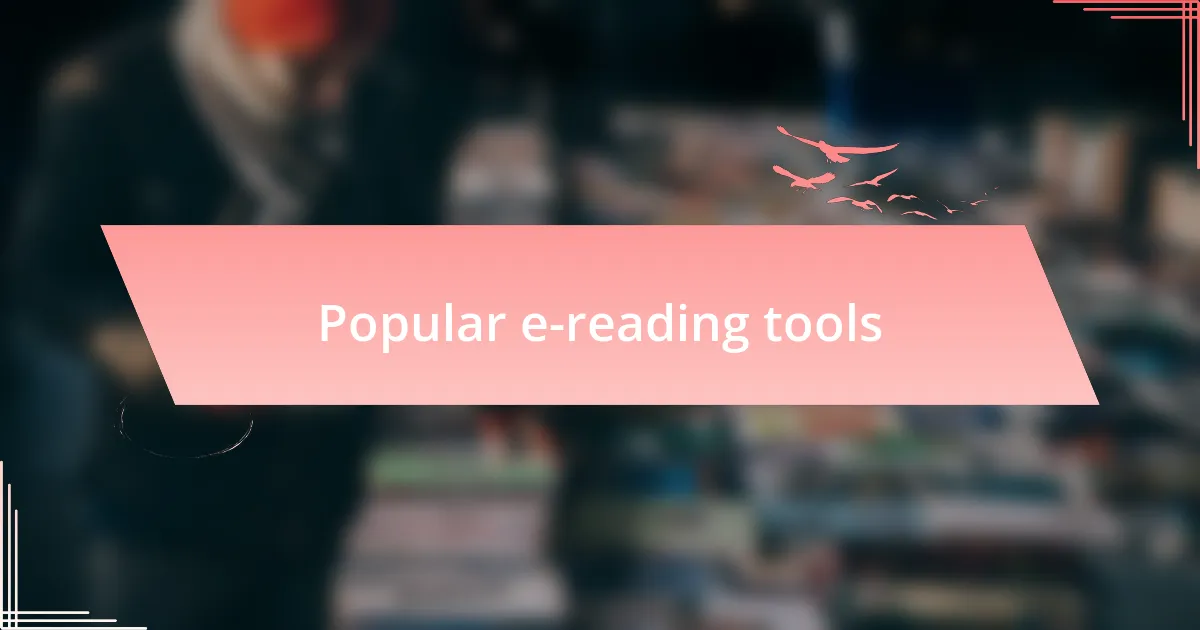
Popular e-reading tools
When it comes to popular e-reading tools, I often find myself turning to Kindle for its seamless user interface and vast library. I once borrowed a Kindle from a friend during a vacation, and its adjustable font sizes and background colors were a game-changer. I could easily customize my reading experience, making it accessible and enjoyable, regardless of the lighting conditions or my mood.
Another tool worth mentioning is Adobe Digital Editions. I remember the first time I used it; I was amazed at how it allowed me to highlight and annotate text effortlessly. For someone who loves to engage deeply with reading material, this feature is pivotal, especially for academic texts or complex narratives. Have you ever wished to revisit your thoughts without flipping through pages? This tool tackles that beautifully.
Lastly, I can’t overlook the benefits of Read Aloud features available in apps like Apple Books. I recall listening to a classic novel while multitasking, and it opened my eyes to how auditory support can enhance comprehension. This feature is not just for those with visual impairments; it can transform the reading experience for anyone who learns better by listening. How do you prefer to absorb your books?
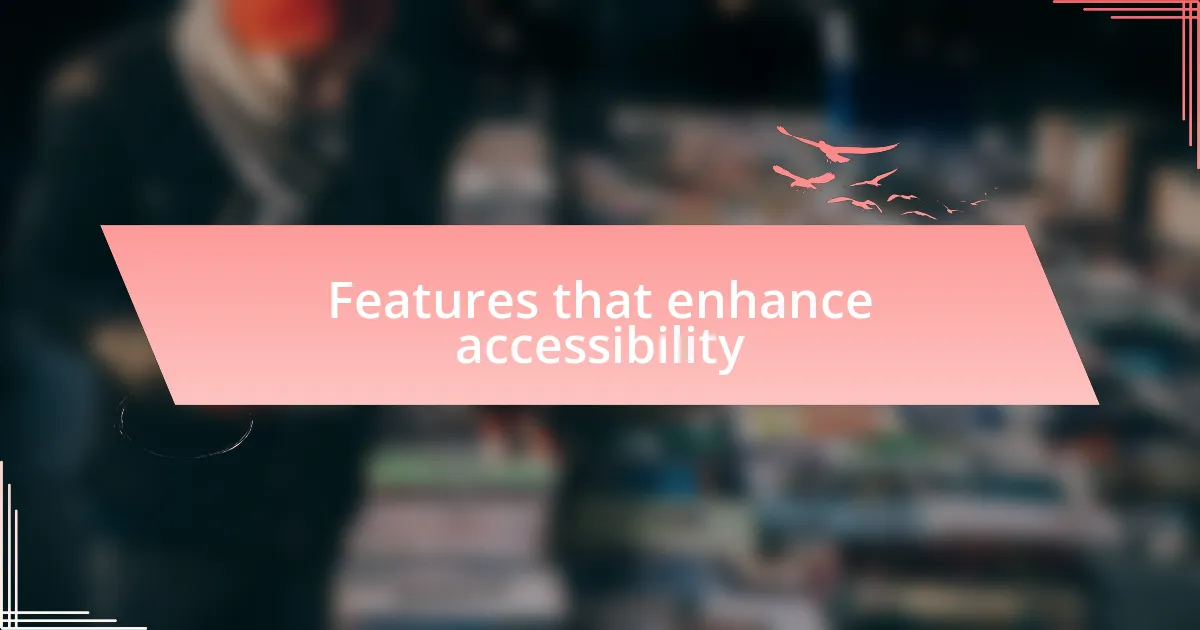
Features that enhance accessibility
When considering features that enhance accessibility, one that stands out for me is text-to-speech functionality. I vividly remember my first experience with this feature on an e-reader app; it almost felt like the words were coming to life. The narrator’s voice added a whole new layer to the reading experience, transforming a solitary activity into a more immersive encounter. Have you ever listened to a story unfold, as if being read to as a child? It can evoke emotions and imagination in ways that the printed word alone cannot.
Another remarkable feature is the option for customizable fonts and colors. I find that when I change the font style, it can significantly affect how comfortable I feel while reading. During my time with different e-books, I discovered that a sans-serif font paired with a soft yellow background reduced eye strain immensely. It’s fascinating how minor adjustments can lead to a more enjoyable escape into a book, don’t you think?
Lastly, the incorporation of screen magnification features is vital for making e-books more accessible. I once encountered a friend who had trouble seeing small text on traditional websites, and when they discovered this tool, it was like a new door had been opened. The joy on their face was unforgettable as they realized they could read without stress. Isn’t it amazing how technology can bridge the gap and ensure everyone has access to stories and knowledge?
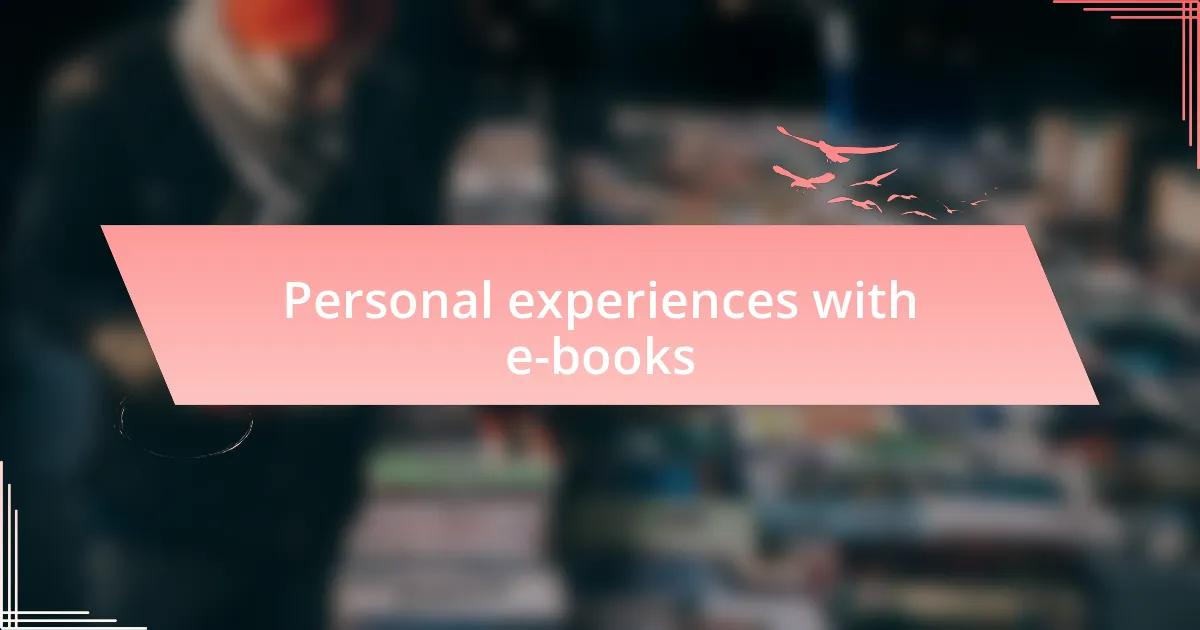
Personal experiences with e-books
I remember the first time I downloaded an e-book on my tablet during a long train ride. As I settled into my seat, the weight of the physical book I usually carried was gone, replaced by the convenience of having multiple titles at my fingertips. There’s something exhilarating about knowing you can switch genres or re-read favorites in an instant—it’s like having a personal library that fits in my bag.
One evening, I tried reading in the dark with an e-reader that had a built-in light feature. I was surprised by how easy it was on my eyes compared to the heavy paperback I typically used. It made me think about how little things like adjustable brightness can transform a reading moment into a relaxing escape, even late at night. Have you felt that shift in atmosphere when the right lighting hits?
During a recent weekend, I discovered the wonders of social reading features within my e-reading app. I joined a virtual book club, and discussing chapters with others as we read at our own pace turned the solitary practice of reading into a shared experience. It felt liberating to connect with others through words, even while physically apart. Isn’t it incredible how e-books can create community in a digital world?
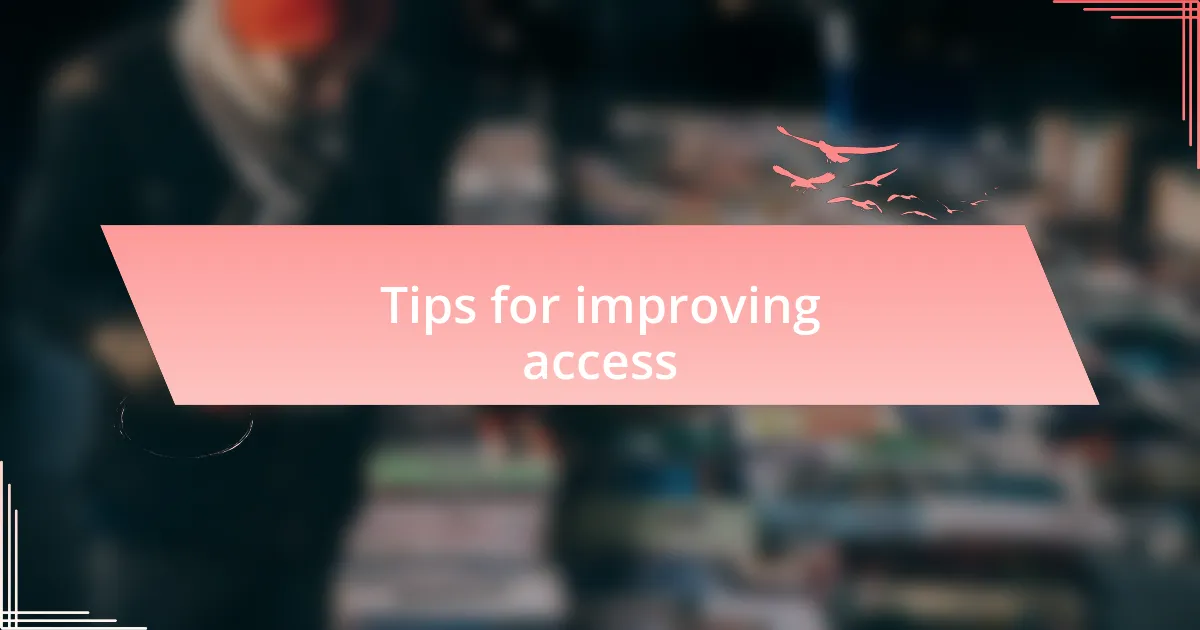
Tips for improving access
To enhance e-book accessibility, I believe one of the simplest yet most effective strategies is to utilize features like text-to-speech. I’ve often relied on this function during long hours of commuting; the ability to listen to a book while managing tasks has been a game changer. Have you ever tried listening to your e-books? It can turn an ordinary moment into an immersive experience.
Another vital tip is to explore font and layout options. For instance, I’ve experimented with larger fonts and increased spacing, which made reading significantly more comfortable, especially during longer sessions. Wouldn’t you agree that a little customization can make a huge difference in how enjoyable e-reading can be?
Also, consider offering e-books in multiple formats. I recall struggling to read a particular title because it was only available in a format that didn’t suit my device. Letting users choose from formats like PDF, EPUB, or MOBI ensures everyone can access their favorite stories without frustration. This flexibility is not just a convenience; it encourages more people to join the e-reading community.